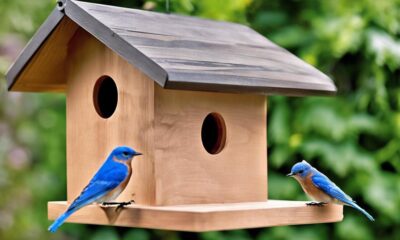Christmas Decoration
Why Do We Have Decorations at Christmas
2025
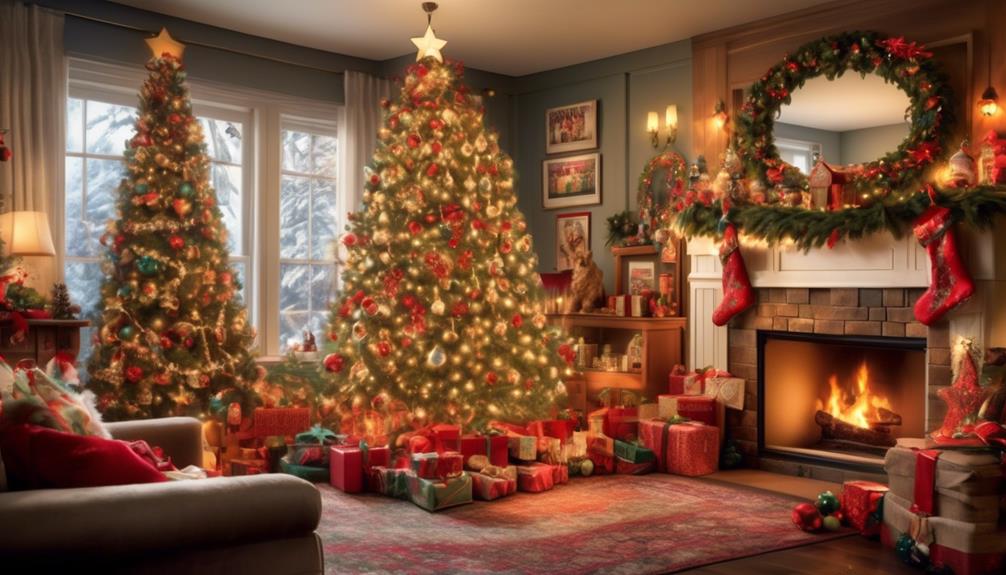
Throughout the festive period, our living spaces come alive with seasonal decor that infuses our environments with a sense of warmth and happiness. These decorations act as emblematic expressions of the Christmas festivities. From the glittering lights enveloping the tree to the vibrant ornaments and wreaths that decorate our living spaces, every piece of decor carries its own meaningful symbolism.
But why do we have decorations at Christmas? In this article, we will explore the historical origins and traditions behind these festive adornments. We will delve into the symbolism behind Christmas trees, ornaments, and lights, as well as the role of wreaths and garlands. Additionally, we will discover how various cultures around the world embrace unique decorating traditions.
Join us as we unravel the magic and meaning behind the decorations that make Christmas truly special.
Key Takeaways
- Christmas decorations have historical origins dating back to ancient civilizations and merge pagan traditions with Christian beliefs.
- The symbolism behind Christmas ornaments and lights represents hope, joy, protection, generosity, and the true meaning of Christmas.
- Christmas decorations play a significant role in creating a festive atmosphere by evoking emotions, building excitement, and promoting unity and happiness.
- Different countries have unique regional decorating styles, showcasing their cultural traditions and creativity during the holiday season.
Historical Origins of Christmas Decorations
Historically, the origins of Christmas decorations can be traced back to ancient civilizations and religious practices, where festive adornments were used to celebrate the winter solstice and honor deities associated with fertility and rebirth. These early decorations held a significant historical significance, as they were deeply rooted in cultural symbolism and represented the beliefs and values of these ancient societies.
In ancient Rome, for example, the festival of Saturnalia, which took place in late December, was marked by the hanging of greenery such as holly and ivy. These plants symbolized fertility and the promise of new life in the coming spring. Similarly, the ancient Egyptians adorned their homes and temples with green palm leaves during the winter solstice to celebrate the return of longer days and the renewal of life.
In later centuries, as Christianity spread throughout Europe, these pagan traditions merged with Christian beliefs to form the basis of modern Christmas decorations. The evergreen tree, for instance, became a prominent symbol of eternal life and the resurrection of Christ. The tradition of decorating trees with candles also originated from ancient practices of lighting bonfires and candles to ward off evil spirits during the darkest time of the year.
Understanding the historical origins of Christmas decorations allows us to appreciate the rich cultural symbolism that has been passed down through generations. These ornaments not only add beauty to our homes during the holiday season, but they also serve as a reminder of the ancient traditions and beliefs that continue to shape our celebrations today.
The Significance of Christmas Trees
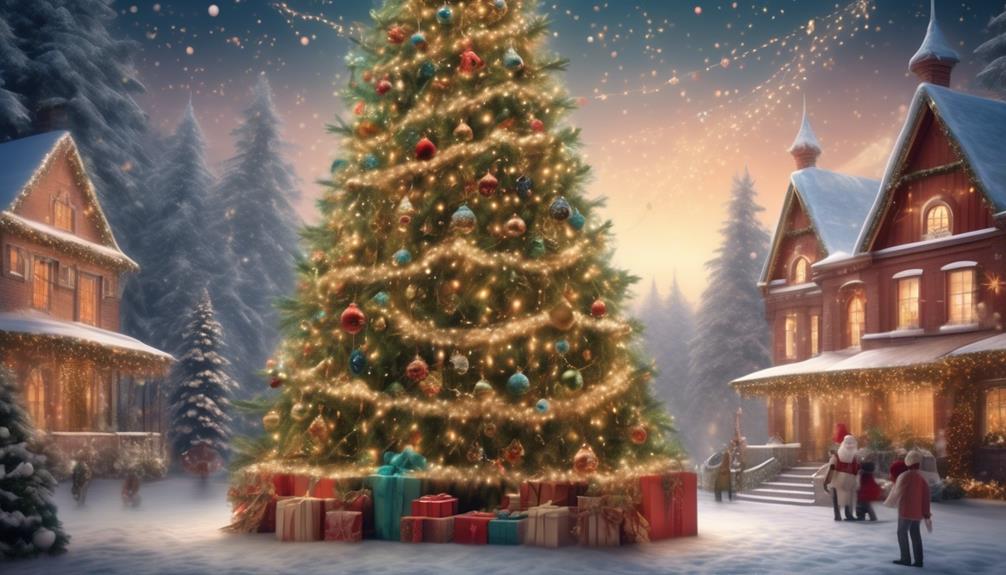
When it comes to the significance of Christmas trees, there are several key points to consider.
Firstly, the evergreen nature of the tree symbolizes eternal life, reflecting the Christian belief in the birth of Jesus and the promise of salvation.
Additionally, the tradition of decorating trees during the Christmas season is deeply rooted in history, dating back to ancient pagan rituals.
Lastly, the Christmas tree has become a universal symbol of hope and joy, serving as a focal point for families to gather around and celebrate during the holiday season.
Evergreen Symbolizes Eternal Life
Evergreen trees hold a significant symbol of eternal life in the context of Christmas decorations. The evergreen symbolism has deep cultural significance and has been associated with various celebrations throughout history. The use of evergreen trees during the Christmas season can be traced back to ancient times when people believed that evergreen plants possessed special powers to ward off evil spirits and bring good luck. This belief gradually merged with Christian traditions, and the evergreen tree became a symbol of eternal life through Jesus Christ. The table below provides a brief overview of the cultural significance of evergreen trees in different regions:
| Region | Cultural Significance |
|---|---|
| Europe | Evergreen trees represented the persistence of life during the harsh winter months. |
| Ancient Rome | Romans decorated trees with small metal ornaments to celebrate the festival of Saturnalia. |
| Northern Asia | Trees were adorned with bright lanterns to celebrate the winter solstice and the return of longer days. |
| North America | Native American tribes used evergreen branches in their winter rituals, symbolizing rebirth and renewal. |
The evergreen tree's association with eternal life continues to be a cherished tradition in many cultures today, serving as a reminder of hope, renewal, and the everlasting spirit of Christmas.
Tradition Rooted in History
Christmas trees hold a significant place in our holiday traditions, symbolizing the spirit of Christmas and carrying with them a rich history that spans centuries. They've a deep historical significance and are an integral part of our cultural heritage. Here are some key points to understand the importance of Christmas trees:
- Origin: The tradition of decorating evergreen trees can be traced back to ancient civilizations such as the Egyptians, Romans, and Vikings.
- Christian Symbolism: The use of evergreen trees during Christmas became popular in medieval Germany, symbolizing everlasting life through Jesus Christ.
- Influence of Prince Albert: The popularity of Christmas trees soared in the 19th century when Queen Victoria's husband, Prince Albert, introduced the tradition to the British Royal family.
- Global Adoption: Christmas trees gained worldwide recognition and became a cherished tradition across different cultures and countries.
- Decorative Evolution: Over time, the decoration of Christmas trees has evolved, incorporating lights, ornaments, and garlands to create a festive and joyful atmosphere.
The historical significance and cultural heritage associated with Christmas trees make them an essential part of our festive celebrations, reminding us of the timeless traditions that have been passed down through generations.
Symbol of Hope and Joy
Having understood the historical significance and cultural heritage associated with Christmas trees, we can now delve into their deeper meaning as a symbol of hope and joy during the holiday season.
The Christmas tree serves as a symbolic representation of these emotions, bringing a sense of warmth and happiness to homes around the world. The cultural significance of the Christmas tree lies in its ability to evoke feelings of anticipation and excitement, reminding us of the joyous festivities that await.
The evergreen nature of the tree symbolizes hope, as it remains vibrant and alive even during the cold winter months. The act of decorating the tree is a cherished tradition that brings families together, fostering a sense of togetherness and unity.
The sight of a beautifully adorned Christmas tree fills our hearts with hope and joy, reminding us of the true spirit of the holiday season.
Symbolism Behind Ornaments and Lights

As we explore the rich history and cultural significance of Christmas decorations, it becomes evident that ornaments and lights hold deep symbolism that enhances the festive atmosphere. The symbolism of Christmas ornaments goes beyond their aesthetic appeal; they represent various aspects of the holiday season. Here are some key symbolic meanings associated with Christmas ornaments:
- Stars: The star-shaped ornaments symbolize the Star of Bethlehem, which guided the wise men to the birthplace of Jesus. They serve as a reminder of the hope and light that Christmas brings.
- Angels: Angel ornaments represent the angelic messengers who announced the birth of Jesus. They symbolize protection, guidance, and divine presence.
- Bells: Bells are often used as ornaments and serve as a reminder of the joyous news of Jesus' birth. Their ringing sound symbolizes celebration and merriment.
- Crosses: Cross-shaped ornaments symbolize the crucifixion of Jesus and the sacrifice he made for humanity. They serve as a reminder of the true meaning of Christmas.
- Ornaments in the shape of gifts: These ornaments symbolize the gifts brought by the wise men to baby Jesus. They represent generosity, giving, and the spirit of Christmas.
In addition to ornaments, Christmas lights also hold great importance in the symbolism of the holiday season. They represent the following:
- Light and warmth: Christmas lights symbolize the warmth and light that Jesus brought into the world. They create a cozy atmosphere and evoke feelings of comfort and joy.
- Hope: The lights shining in the darkness symbolize hope during the winter season. They remind us that even in the darkest times, there's always a glimmer of hope.
- Unity and togetherness: Christmas lights bring people together, symbolizing the unity and togetherness of family and friends during the holiday season.
- Celebration: The bright and colorful lights symbolize the joyous celebration of Christmas. They create a festive ambiance and set the mood for celebrations and gatherings.
- Spiritual enlightenment: Christmas lights also represent spiritual enlightenment and the illumination of one's faith during the Christmas season.
The Role of Wreaths and Garlands
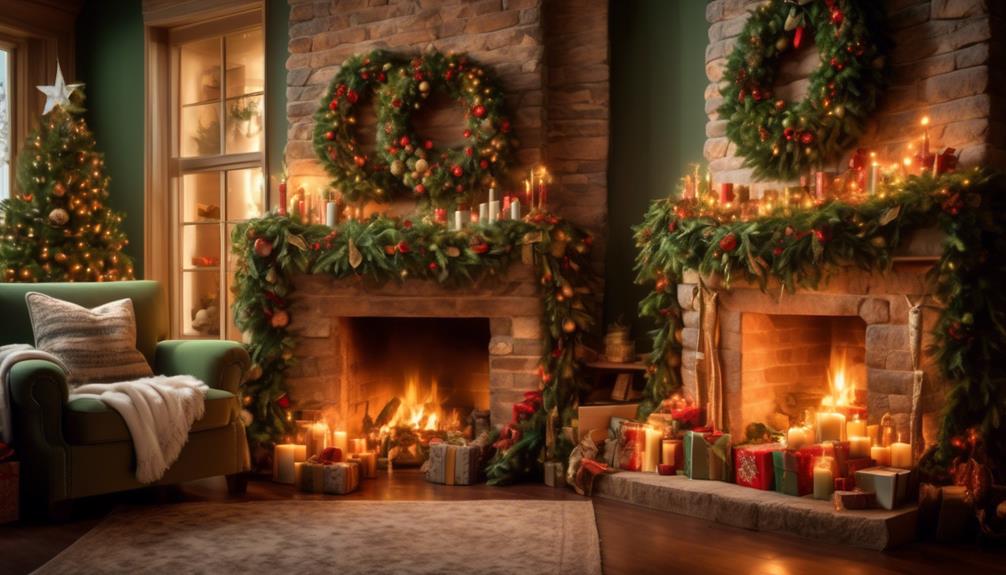
Continuing our exploration of the rich symbolism behind Christmas decorations, we now turn our attention to the significant role that wreaths and garlands play in enhancing the festive atmosphere. Traditionally crafted from evergreen leaves, wreaths are seen as a representation of eternal life and the cyclical nature of the seasons. Garlands, draped elegantly across mantels or staircases, symbolize abundance and joy, further elevating the holiday spirit. For those looking to complement these adornments, incorporating creative stocking decoration ideas can add an extra layer of personal charm to your Christmas setup.
Wreaths and garlands have deep cultural significance and carry symbolic meanings that date back centuries.
Wreaths, typically made from evergreen branches, symbolize eternity and the cycle of life. Their circular shape represents the unending nature of time and the hope for new beginnings. In ancient times, wreaths were used to honor gods and celebrate important occasions. Today, they serve as a welcoming symbol, adorning doors and windows to invite joy and good fortune into the home.
Garlands, on the other hand, are long strands of greenery, often embellished with ornaments or lights. They symbolize abundance and fertility, as they were traditionally used to decorate homes during harvest festivals. Today, garlands are used to create a festive atmosphere and bring a touch of nature indoors. They can be draped over mantelpieces, staircases, or even hung along walls to add a charming and whimsical touch to any space.
For those looking to personalize their Christmas decorations, there are countless creative DIY wreath and garland ideas available. From using unconventional materials like pinecones and berries to incorporating personal mementos and photographs, the possibilities are endless. Creating your own wreaths and garlands not only adds a personal touch to your festive décor but also allows you to express your creativity and make unique pieces that reflect your own style and personality.
Traditional Christmas Colors and Their Meanings
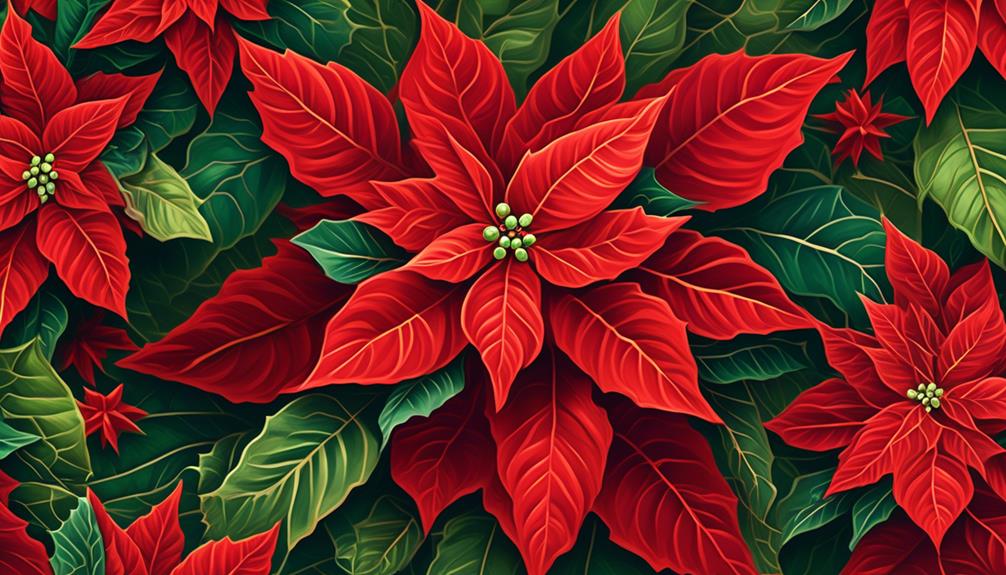
Traditional Christmas colors hold deep symbolic meanings that have been passed down through generations, adding an extra layer of significance to our holiday celebrations. These colors have become ingrained in our cultural traditions and are instantly recognizable as symbols of the season. Let's explore the symbolism of these traditional Christmas colors:
- Red: The color red is associated with warmth, love, and joy. It represents the blood of Christ and is a reminder of his sacrifice. Red is also reminiscent of the holly berries commonly used in Christmas decorations.
- Green: Green is a symbol of life, renewal, and nature. It represents the everlasting hope and the promise of new beginnings. The use of evergreen trees and wreaths during Christmas further emphasizes this connection to nature.
- Gold: Gold is a color of richness, royalty, and divine light. It represents the glory and majesty of the birth of Jesus. Gold also symbolizes the gifts of the Magi, who brought precious treasures to the baby Jesus.
- White: White is associated with purity, innocence, and peace. It symbolizes the virgin birth of Jesus and the purity of his mother, Mary. White is often used in Christmas decorations to evoke a sense of serenity and tranquility.
- Silver: Silver represents illumination, clarity, and reflection. It symbolizes the starry night when the shepherds witnessed the birth of Jesus. The shimmering quality of silver also adds a touch of elegance and magic to Christmas decorations.
Understanding the symbolism behind these traditional Christmas colors enhances our appreciation for the season and deepens our connection to the religious and cultural traditions that have been passed down to us.
Decorating Traditions From Around the World
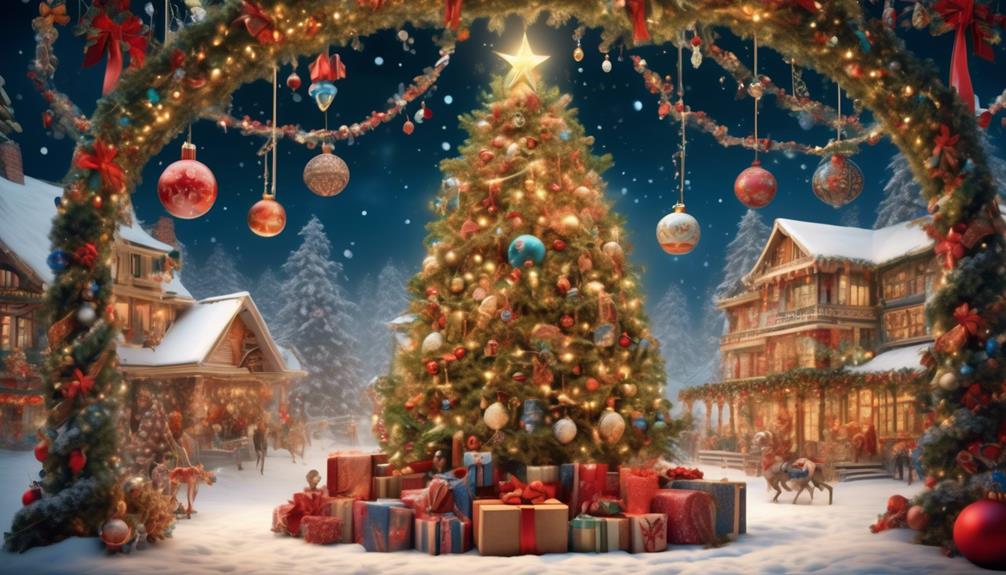
When it comes to Christmas decorations, they aren't just about adding a festive touch to our homes, but they also hold cultural symbolism and historical significance.
Exploring decorating traditions from around the world allows us to understand the diverse ways in which different cultures celebrate the holiday season.
From the historical origins of these traditions to the unique regional styles of decorations, there's much to discover and appreciate about the global diversity of Christmas decor.
Cultural Symbolism of Decorations
As we explore the cultural symbolism of Christmas decorations, it becomes evident that various countries and regions around the world have developed unique and meaningful traditions when it comes to adorning their homes during the holiday season. These traditions hold great cultural significance and have a profound psychological impact on individuals.
Here are some examples of decorating traditions from around the world:
- In Germany, the Christmas tree is a central part of the festivities. It's adorned with candles, fruits, and nuts, symbolizing the bounty of nature and the light of Christ.
- In Mexico, nativity scenes, known as 'nacimientos,' are a common decoration. These intricate displays depict the birth of Jesus and reflect the strong religious beliefs of the Mexican people.
- In Japan, Christmas decorations often include paper lanterns and origami ornaments. These delicate decorations evoke a sense of tranquility and simplicity.
- In Sweden, the tradition of 'Julbock' involves placing a straw goat ornament in the home. This symbolizes the mythical creature that brings gifts and good fortune during the holiday season.
- In Australia, Christmas decorations often incorporate native flora, such as eucalyptus leaves and kangaroo paw flowers. This reflects the country's unique natural environment and adds a touch of uniqueness to the festive atmosphere.
These diverse traditions highlight the rich cultural tapestry of Christmas celebrations worldwide and remind us of the universal joy and warmth that decorations bring during this special time of year.
Historical Origins of Traditions
While the exact historical origins of Christmas decorating traditions from around the world may vary, they all share a common thread of cultural significance and symbolism. These traditions have evolved over centuries, influenced by different cultures and historical events.
For example, in ancient Rome, wreaths made from evergreen plants were hung on doors and windows as a symbol of victory and strength.
In Germany, the tradition of decorating Christmas trees dates back to the 16th century, when devout Christians brought evergreen trees into their homes and adorned them with candles to represent the light of Christ.
In Mexico, the use of poinsettias in Christmas decorations stems from a legend of a poor girl offering weeds as a gift to the baby Jesus, which miraculously turned into vibrant red flowers.
These historical origins highlight the cultural symbolism behind Christmas decorations and remind us of the rich traditions that have been passed down through generations.
Unique Regional Decorating Styles
Unique regional decorating styles from around the world showcase the diverse cultural traditions and artistic expressions associated with Christmas festivities. These regional decorating techniques not only add beauty and charm to the holiday season but also hold deep cultural significance.
Here are some unique regional decorating styles:
- Germany: The Germans are known for their intricate glass-blown ornaments and handmade wooden decorations, such as nutcrackers and pyramids.
- Mexico: In Mexico, vibrant paper decorations called papel picado are hung, along with handmade clay figurines of the Nativity scene.
- Sweden: Swedish Christmas decorations often feature red and white colors, with straw ornaments called Julgranskram that are hung on the Christmas tree.
- Japan: In Japan, you'll find minimalist decorations like origami paper ornaments and small, ornamental trees called 'mini trees.'
- Australia: Due to the summer season, Australians decorate with festive beach-themed decorations, such as seashells, palm fronds, and surfboards.
These regional decorating styles reflect the unique cultural heritage and traditions of each country, making Christmas celebrations around the world truly special and diverse.
How Decorations Contribute to the Festive Atmosphere

Christmas decorations play a pivotal role in creating a festive ambiance that fills our homes and hearts with joy and excitement during the holiday season. These decorations go beyond mere aesthetics; they have profound psychological effects that contribute to the overall atmosphere of celebration and happiness.
When we adorn our homes with twinkling lights, colorful ornaments, and fragrant evergreen wreaths, we are tapping into a tradition that dates back centuries. The act of decorating is an outward expression of our inner joy and anticipation for the holiday season. It signals to ourselves and others that this is a special time of year, deserving of special adornments.
To understand the psychological effects of Christmas decorations, let's take a closer look at how they contribute to the festive ambiance:
| Psychological Effects | Contribution to Festive Ambiance |
|---|---|
| Nostalgia | Evokes memories of past holidays |
| Excitement | Builds anticipation for Christmas |
| Comfort | Creates a cozy and welcoming environment |
| Unity | Encourages togetherness and shared experiences |
| Happiness | Generates feelings of joy and contentment |
Frequently Asked Questions
What Are Some Popular Modern Christmas Decoration Trends?
Some popular modern Christmas decoration trends include minimalist designs, natural elements like pine cones and greenery, and DIY Christmas crafts. These trends reflect a desire for simplicity and a personal touch in holiday decor.
How Can I Make My Own Homemade Christmas Decorations?
We all love getting crafty during the holidays, don't we? When it comes to DIY Christmas crafts, making homemade ornaments is always a hit. Let's dive into some creative ideas!
Are There Any Specific Rules or Guidelines for Decorating a Christmas Tree?
Guidelines and tips for decorating a Christmas tree include choosing a theme or color scheme, arranging lights and ornaments evenly, and adding a tree topper. These steps can create a beautiful and festive centerpiece for the holiday season.
What Are Some Eco-Friendly Alternatives to Traditional Christmas Decorations?
Eco-friendly Christmas decorations offer sustainable holiday decor options. From recycled materials to natural elements, these alternatives help reduce our environmental impact. By choosing eco-friendly options, we can celebrate the season while being mindful of the planet.
Are There Any Superstitions or Folklore Associated With Specific Christmas Decorations?
We have mistletoe and holly in Christmas traditions due to their origins and symbolism. Stockings play a role in folklore and gift giving traditions. They connect us to the joy and excitement of receiving gifts during the holiday season.
Conclusion
In conclusion, Christmas decorations serve as a magical tapestry that weaves together the historical origins, symbolism, and traditions of this beloved holiday.
Like shimmering ornaments adorning a majestic tree, they bring joy and beauty to our homes, creating a festive atmosphere that captures the spirit of Christmas.
These decorations, with their rich colors and intricate designs, serve as a visual reminder of the season's meaning and the love and warmth we share with our loved ones.
They're the finishing touch that completes the enchanting tableau of Christmas.
- About the Author
- Latest Posts
Introducing Ron, the home decor aficionado at ByRetreat, whose passion for creating beautiful and inviting spaces is at the heart of his work. With his deep knowledge of home decor and his innate sense of style, Ron brings a wealth of expertise and a keen eye for detail to the ByRetreat team.
Ron’s love for home decor goes beyond aesthetics; he understands that our surroundings play a significant role in our overall well-being and productivity. With this in mind, Ron is dedicated to transforming remote workspaces into havens of comfort, functionality, and beauty.

Picture turning your used artificial Christmas tree into a beautiful garden ornament. By using some creativity and expertise, you can spruce up your garden for the holidays while also being environmentally conscious.
In this article, we’ll show you how to recycle artificial Christmas trees to decorate your garden. From selecting the right tree to preparing it for outdoor use, we’ll provide practical tips and creative ideas to help you repurpose your holiday tree and add a touch of magic to your outdoor space.
Key Takeaways
- Choose a tree size and shape that fits well in your garden space.
- Upcycle your artificial tree by adding bird feeders, hanging flower baskets, or string lights.
- Repurpose your tree with imagination and turn it into a unique garden decoration.
- Regularly water live branches and remove any dead or wilted foliage.
Selecting the Right Artificial Christmas Tree for Garden Decor
You should start by choosing the right artificial Christmas tree for your garden decor. An outdoor Christmas tree can be a stunning addition to your garden, adding a touch of festive charm. When selecting your tree, consider the size and shape that will fit best in your garden space.
Look for a tree that’s specifically designed for outdoor use, as it will be more durable and weather-resistant. Additionally, consider the style and color of your garden ornaments to ensure that your tree complements your existing decor.
Whether you prefer a traditional green tree or a more unique color, such as white or silver, there are plenty of options available. By selecting the right artificial Christmas tree, you can create a magical outdoor display that will delight both you and your guests.
Preparing the Artificial Christmas Tree for Outdoor Use
Get your outdoor space ready by making sure your artificial tree is properly prepared for use. Before placing your tree in the garden, consider upcycling options to give it a new purpose. You can transform your artificial tree into a unique garden decoration by adding bird feeders, hanging flower baskets, or even string lights. To ensure its longevity, weatherproofing techniques are essential. Here are some tips to protect your tree from the elements:
| Weatherproofing Techniques | Upcycling Options |
|---|---|
| Apply a waterproof sealant | Bird feeders |
| Use UV-resistant spray paint | Hanging flower baskets |
| Wrap the base with plastic | String lights |
Creative Ideas for Repurposing Artificial Christmas Trees in the Garden
Transforming your artificial tree into a unique garden decoration can add a touch of creativity to your outdoor space. Instead of throwing away your old Christmas tree, consider repurposing it for outdoor crafts and giving it a new life in your garden.
Here are some unique ways to use artificial Christmas trees in the garden:
-
Create a bird feeder: Hang pinecones filled with birdseed from the branches of the tree. The birds will love having a feeding station in your garden.
-
Make a wreath: Use the branches of the artificial tree to create a beautiful wreath for your garden gate or front door. Add some colorful decorations to make it truly unique.
-
Build a garden trellis: Use the sturdy branches of the tree to create a trellis for your climbing plants. It won’t only support their growth but also add a whimsical touch to your garden.
With a little imagination, you can repurpose your artificial Christmas tree and turn it into a one-of-a-kind garden decoration.
Tips for Decorating the Garden With Recycled Artificial Christmas Trees
Spruce up your outdoor space by repurposing your old holiday tree into unique decorations for your garden. Transforming your artificial Christmas tree into DIY outdoor Christmas tree decorations is a fun and eco-friendly way to add a festive touch to your garden all year round. Check out the table below for some creative ideas on how to repurpose your artificial Christmas tree:
| Decoration Idea | Materials Needed | How to Make |
|---|---|---|
| Miniature Tree | Tree branches, pots, decorations | Cut branches to desired length and attach to a small pot. Decorate with ornaments and lights. |
| Garland | Tree branches, wire | Bend wire into desired shape and attach branches. Hang as garland around fences or pergolas. |
| Bird Feeder | Tree branches, birdseed, wire | Attach branches together to form a platform. Fill with birdseed and hang from a tree branch. |
Now that you have some ideas for repurposing your artificial Christmas tree, let’s move on to the next section to learn how to maintain and care for these decorations in your garden.
Maintaining and Caring for Artificial Christmas Tree Decorations in the Garden
To keep your outdoor Christmas tree decorations looking their best, make sure to regularly water any live branches and remove any dead or wilted foliage. Caring for artificial Christmas tree decorations in the garden requires some attention and maintenance. Here are some tips to help you protect and maintain your artificial Christmas trees in the garden:
-
Provide proper support: Use sturdy stakes or a tree stand to secure your artificial tree in the garden, especially in windy conditions.
-
Clean regularly: Dust and debris can accumulate on your artificial tree, so make sure to clean it regularly with a soft brush or cloth to maintain its appearance.
-
Protect from harsh weather: Extreme weather conditions like heavy rain, snow, or strong winds can damage your artificial tree. Consider using a protective cover or moving it to a sheltered area during inclement weather.
Frequently Asked Questions
Can I Use a Real Christmas Tree for Garden Decor Instead of an Artificial One?
You can definitely use a real Christmas tree for garden decor instead of an artificial one. However, there are some benefits to using an artificial tree, such as durability and reusability.
How Do I Determine the Correct Size of Artificial Christmas Tree to Use in My Garden?
To determine the correct size of an artificial Christmas tree for your garden, measure the available space and consider the overall aesthetic you want to achieve. Choose a tree that fits well and complements your garden’s design.
Can I Leave My Artificial Christmas Tree Outside in All Weather Conditions?
You shouldn’t leave your artificial Christmas tree outside in all weather conditions. It’s important to protect it from harsh elements to ensure its longevity. Follow best practices for outdoor decoration to keep it looking great.
Are There Any Safety Precautions I Should Take When Repurposing an Artificial Christmas Tree in the Garden?
When repurposing an artificial Christmas tree in the garden, it’s important to take safety precautions. Follow these repurposing tips to ensure a safe and successful project.
How Often Should I Clean and Maintain My Recycled Artificial Christmas Tree Decorations in the Garden?
You should clean and maintain your recycled artificial Christmas tree decorations in the garden regularly. Dust and debris can accumulate, so a quick wipe-down and inspection every few weeks will keep them looking fresh and festive.
Conclusion
In conclusion, recycling artificial Christmas trees to decorate your garden is a practical and creative way to add a festive touch to your outdoor space. By selecting the right tree, preparing it for outdoor use, and implementing creative ideas for repurposing, you can create a unique garden decor that will impress your guests.
Remember to maintain and care for your artificial tree decorations to ensure they last for many seasons to come. Happy gardening!
- About the Author
- Latest Posts
Introducing Charles, the Editor in Chief at ByRetreat, whose passion for interior design and editorial excellence elevates every remote workspace to new heights. With his keen eye for detail, impeccable taste, and expertise in design, Charles brings a wealth of knowledge and creativity to the ByRetreat team.
As the Editor in Chief of a renowned lifestyle blog, Charles has honed his skills in curating captivating content and staying up-to-date with the latest trends in interior design. His deep understanding of aesthetics and the power of storytelling through design enables him to create remote workspaces that are not only visually stunning but also rich in personality and meaning.
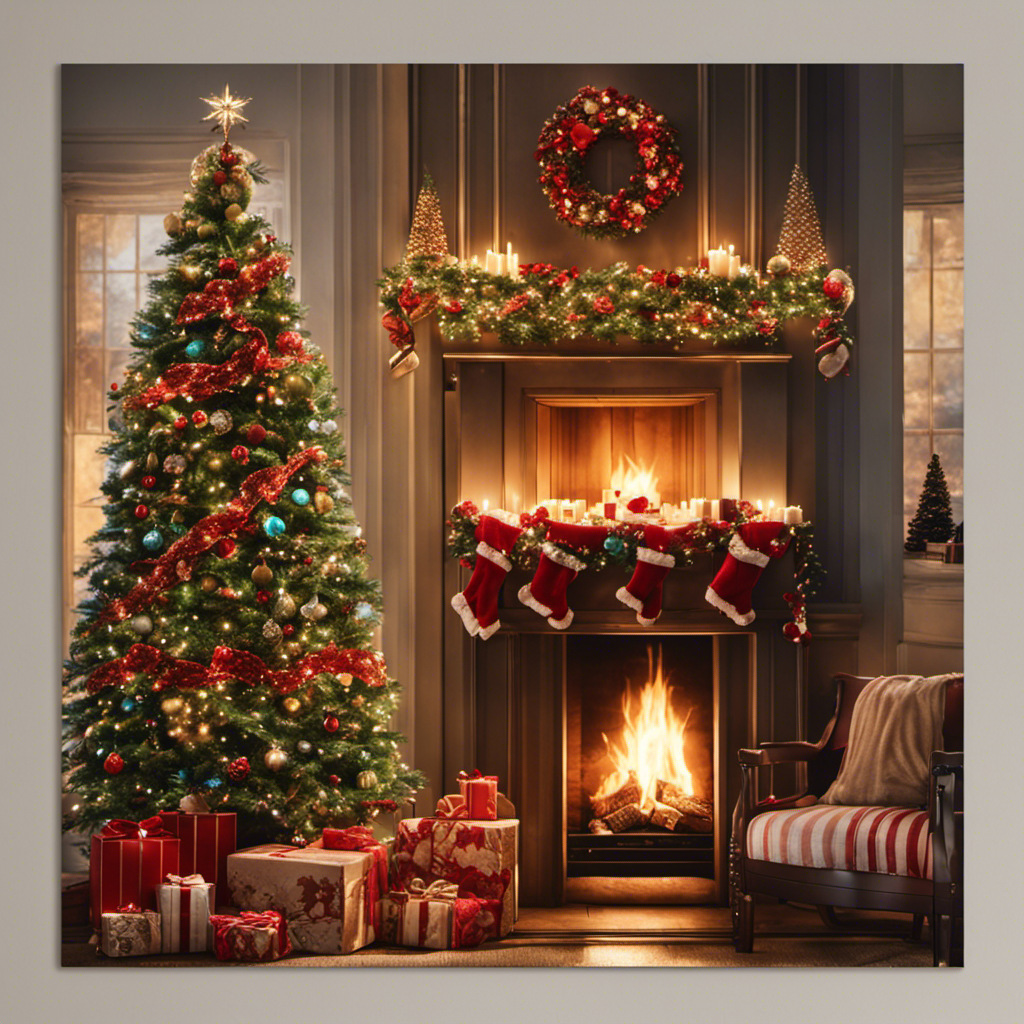
Have you ever thought about when is the right time to remove your Christmas decorations?
In the British tradition, there is a specific date that marks the end of the festive season. Known as Twelfth Night, it falls on January 5th, twelve days after Christmas Day.
This longstanding practice has its historical origins and regional variations across the UK. Understanding the significance of this tradition and its modern interpretation can add a touch of sophistication to your holiday celebrations.
Key Takeaways
- The tradition of taking down Christmas decorations originated in the Victorian era and was believed to bring bad luck if decorations were left up past Twelfth Night.
- Twelfth Night, celebrated on January 6th, marks the end of the Christmas season and symbolizes the visit of the three wise men to baby Jesus.
- The traditional date for taking down decorations is January 6th, but there are regional variations in the UK, with Scotland, Northern Ireland, and Wales having their own customs.
- Modern interpretation of the tradition allows for more flexibility, with some people choosing to take down decorations earlier or keep them up longer to extend the festive atmosphere.
Historical Origins of the Tradition
You might be wondering where the tradition of taking down Christmas decor originated. Well, let’s delve into its historical significance and cultural customs.
The tradition of removing Christmas decorations dates back to the Victorian era in Britain. During this time, Christmas trees were adorned with candles, ribbons, and ornaments, creating a festive atmosphere. However, it was believed that leaving the decorations up past Twelfth Night, which falls on January 5th or 6th, would bring bad luck for the coming year.
Twelfth Night is the traditional end of the Christmas season and marks the arrival of the Feast of the Epiphany. It symbolizes the visit of the three wise men to baby Jesus. Therefore, taking down the decorations before or on Twelfth Night became a customary practice in British culture.
Significance of the Twelfth Night
Celebrate the significance of the Twelfth Night by keeping your holiday decorations up until January 6th. This traditional date marks the end of the Christmas season and is rich in customs and superstitions. Here are three ways to embrace this festive occasion:
-
Wassailing: Gather with friends and family to go door-to-door, singing carols and sharing a warm drink to bless the orchards for a fruitful year ahead.
-
Twelfth Night Cake: Bake a delicious cake with a hidden bean and a pea. The person who finds the bean becomes the king or queen for the night, while the one who discovers the pea must be their servant.
-
Taking down decorations: On Twelfth Night, it’s believed that leaving Christmas decorations up beyond this date brings bad luck. So, bid farewell to the holiday season and prepare for the year ahead by carefully packing away your festive adornments.
As the Twelfth Night festivities come to an end, it’s time to explore the traditional date for taking down decorations.
Traditional Date for Taking Down Decorations
Bid farewell to the holiday season by adhering to the traditional date of January 6th for removing your festive adornments. This date, known as Twelfth Night, has been celebrated for centuries and holds cultural significance in many countries. The belief is that leaving decorations up beyond this date brings bad luck or hinders the arrival of spring.
While some may view this practice as superstitious, it’s an interesting cultural tradition that has stood the test of time.
In addition to cultural beliefs, there’s also an environmental impact to consider when it comes to keeping decorations up for longer periods. Many Christmas decorations are made from non-biodegradable materials, such as plastic and synthetic fibers, which can contribute to pollution and waste.
By adhering to the traditional date, you can minimize the environmental impact and ensure a more sustainable approach to celebrating the holiday season.
Regional Variations in the UK
In the UK, different regions have their own unique customs and practices when it comes to removing holiday decorations. Regional customs often reflect cultural differences and add a touch of diversity to this tradition. Here are three examples of regional variations in the UK:
-
In Scotland, it’s common to take down Christmas decorations on or before January 5th, which is known as ‘Twelfth Night.’ This date marks the end of the Christmas season and the arrival of Epiphany.
-
In Northern Ireland, some households adhere to the tradition of taking down decorations on January 6th, which is also known as ‘Little Christmas’ or ‘Women’s Christmas.’ This day is dedicated to women and is seen as the final opportunity to celebrate the festive season.
-
In Wales, it’s customary to remove decorations on January 7th, known as ‘Festival of Fools.’ This date is associated with a humorous celebration where people play pranks on each other.
These regional customs highlight the rich cultural tapestry of the UK and demonstrate how different communities interpret and celebrate the end of the Christmas season.
Now, let’s delve into the modern interpretation of this tradition.
Modern Interpretation of the Tradition
To put a unique spin on the end of the holiday season, you can embrace a modern interpretation of removing your festive decorations.
Traditionally, the British have followed the custom of taking down Christmas decorations on the twelfth night after Christmas, which falls on January 5th or 6th. However, in recent times, there’s been a shift in cultural significance and more flexibility in interpreting this tradition.
Some people now choose to take down their decorations earlier, either out of convenience or personal preference. Others may choose to keep them up longer, extending the festive atmosphere into the new year.
This modern interpretation allows individuals to personalize the end of the holiday season and reflect their own values and desires, adding a touch of individuality to an age-old tradition.
Frequently Asked Questions
What Are Some Common Types of Christmas Decorations Used in the Uk?
In the UK, people use different types of Christmas decorations. Traditional decorations, like Christmas trees and ornaments, are popular. Some prefer homemade decorations, while others opt for store-bought ones. Christmas lights and fairy lights are also commonly used.
How Do Other Countries Celebrate the End of the Christmas Season?
Different countries have their own unique ways of celebrating the conclusion of the Christmas season. From Spain’s Three Kings Day to Russia’s Old New Year, these end of season festivities showcase cultural diversity and traditions.
Are There Any Specific Rituals or Ceremonies Associated With Taking Down Christmas Decorations in the Uk?
In the UK, taking down Christmas decorations involves various rituals and ceremonies. These practices carry cultural significance and have historical origins. Some alternative traditions have also emerged over time.
Has the Tradition of Taking Down Christmas Decorations on the Twelfth Night Always Been Practiced in the Uk?
The tradition of taking down Christmas decorations on the twelfth night has not always been practiced in the UK. Its historical origins can be traced back to ancient times. However, attitudes towards this tradition have changed in modern-day UK.
Are There Any Superstitions or Beliefs Associated With Leaving Christmas Decorations up Past the Traditional Date for Taking Them Down?
Leaving up Christmas decorations past the traditional date can be seen as bad luck or a sign of laziness. It is important to respect the cultural significance of taking them down on time to avoid any negative superstitions.
Conclusion
So, you’ve finally reached the end of the festive season, and it’s time to bid farewell to your beloved Christmas decorations.
According to tradition, you should wait until the Twelfth Night to take them down. But let’s be honest, who’s got the time or patience for that?
In this modern age, we don’t need to stick to ancient customs. So go ahead, break the tradition, and take down those decorations whenever you please.
After all, rules were made to be broken, right?
- About the Author
- Latest Posts
Introducing Ron, the home decor aficionado at ByRetreat, whose passion for creating beautiful and inviting spaces is at the heart of his work. With his deep knowledge of home decor and his innate sense of style, Ron brings a wealth of expertise and a keen eye for detail to the ByRetreat team.
Ron’s love for home decor goes beyond aesthetics; he understands that our surroundings play a significant role in our overall well-being and productivity. With this in mind, Ron is dedicated to transforming remote workspaces into havens of comfort, functionality, and beauty.
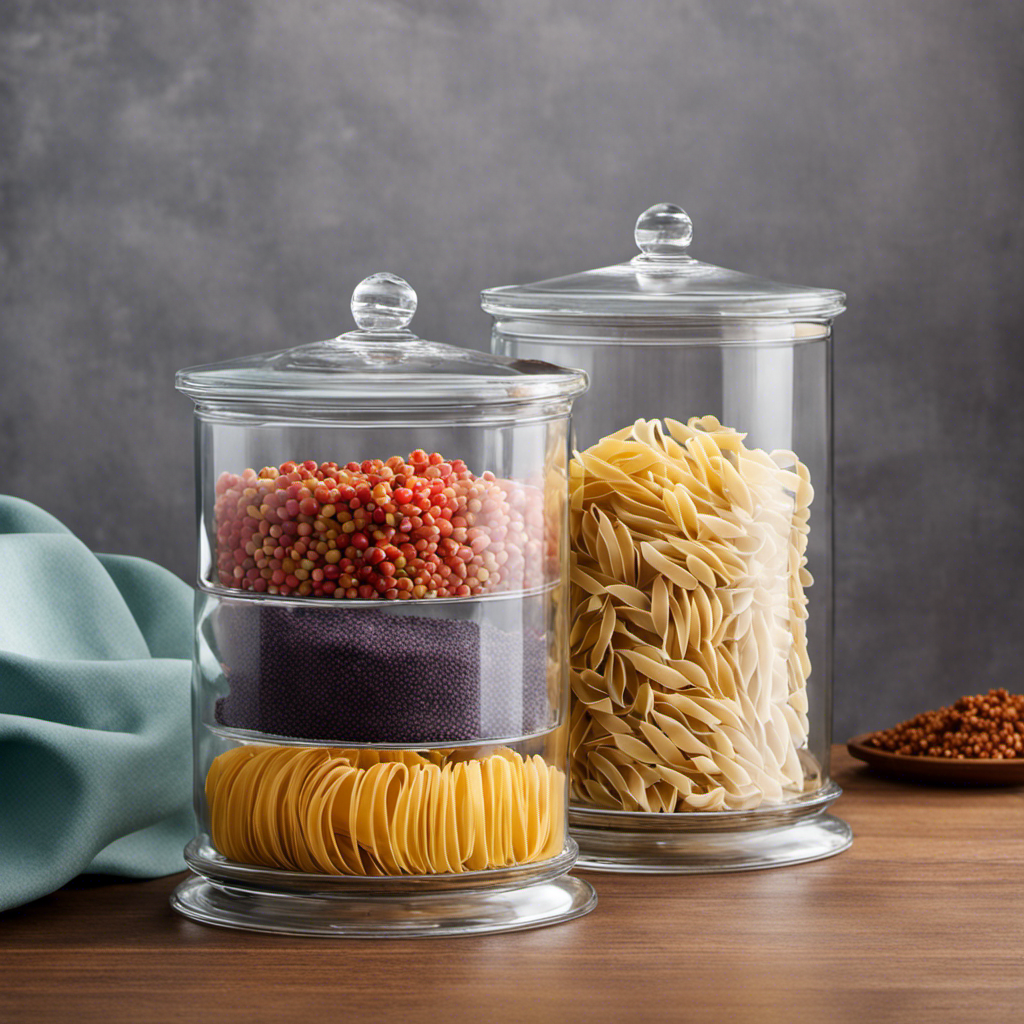
Hey everyone! Have you ever faced difficulties in enhancing your kitchen decor? Don’t worry, because I have some great ideas on what to put in those clear canisters. Believe me, it will make a big difference.
From fresh herbs and spices to colorful dry pasta, and even assorted baking supplies, the options are endless.
Oh, and let’s not forget about dried fruits and nuts, or the heavenly aroma of coffee beans and tea leaves.
Get ready to transform your kitchen into a stylish and functional space!
Key Takeaways
- Fresh herbs and spices bring freshness and vitality to the kitchen
- Colorful dry pasta adds pop of color and personality to the kitchen
- Organized baking supplies save time and add elegance to the kitchen
- Coffee beans and tea leaves in clear canisters add elegance and aroma to the kitchen
Fresh Herbs and Spices
I love filling clear canisters with fresh herbs and spices to add a burst of flavor and color to my kitchen decor.
One of my favorite ways to incorporate herbs into my kitchen is by creating an indoor herb garden. It not only adds a touch of greenery but also provides me with a convenient source of fresh herbs for cooking.
I enjoy the process of selecting different herbs like basil, rosemary, and thyme, and nurturing them as they grow. Not only do they enhance the aroma and taste of my dishes, but they also bring a sense of freshness and vitality to my kitchen.
Additionally, I enjoy experimenting with DIY spice blends. By combining different spices like cumin, paprika, and garlic powder, I can create unique flavors that perfectly complement my culinary creations. Having these spice blends readily available in clear canisters not only adds a decorative touch to my kitchen but also makes it easy for me to access and use them while cooking.
Colorful Dry Pasta
My favorite way to spruce up my kitchen is by using colorful dry pasta as a vibrant and eye-catching decorative element in my home. Not only does it add a pop of color, but it also brings a touch of whimsy and personality to my kitchen decor.
Here are some ideas to inspire you:
-
Different Shaped Pasta: From bowties to spirals, there are so many unique and interesting pasta shapes available. Mix and match them to create a visually appealing display in your clear canisters.
-
Vintage Kitchen Utensils: Pair your colorful dry pasta with vintage kitchen utensils to create a charming and nostalgic vibe. Hang old whisks, spatulas, and ladles on the wall or display them in a jar alongside the pasta.
-
Layered Pasta: Create layers of different colored pasta in your canisters for a stunning visual effect. This is a simple yet effective way to add depth and dimension to your kitchen decor.
Assorted Baking Supplies
One way to organize my assorted baking supplies is by using labeled containers to easily identify and access the ingredients and tools I need.
For my decorative sprinkles, I’ve a clear glass jar that showcases the vibrant colors and textures. It adds a pop of excitement to my kitchen decor, while also keeping my sprinkles fresh and easily accessible.
Another container I use is a small plastic bin for my cookie cutters. I label it ‘Cookie Cutters’ and place it on a shelf within reach. This way, whenever I’m in the mood for baking cookies, I can quickly find the perfect shape without rummaging through drawers.
Organizing my baking supplies in this way not only saves me time but also adds a touch of elegance to my kitchen.
Dried Fruits and Nuts
To keep my dried fruits and nuts fresh, I store them in airtight containers. Not only do dried fruits and nuts add a burst of flavor and texture to any dish, but they also come with numerous health benefits.
Here are some reasons why you should incorporate them into your diet:
- Boost of nutrients: Dried fruits and nuts are packed with essential vitamins, minerals, and antioxidants that promote overall well-being.
- Energy-packed snacks: Whether you’re on-the-go or need a pick-me-up during the day, dried fruits and nuts provide a quick and nutritious energy boost.
- Versatile ingredients: Get creative in the kitchen by using dried fruits and nuts in a variety of recipes, from salads and baked goods to savory dishes like stir-fries and pilafs.
Coffee Beans and Tea Leaves
I love the aroma of freshly ground coffee beans and the soothing taste of steeped tea leaves. There’s something magical about starting the day with a cup of freshly brewed coffee or a fragrant cup of tea.
When it comes to kitchen decor, clear canisters filled with coffee beans and loose leaf tea are a perfect choice. Not only do they add a touch of elegance to the kitchen, but they also serve a practical purpose. The rich, earthy scent of coffee beans fills the air, creating a warm and inviting atmosphere.
The canisters can be arranged on a countertop or displayed on a shelf, allowing you to showcase your favorite blends. To enhance the visual appeal, you can also add a few sprigs of aromatic herbs like lavender or mint to the canisters. This not only adds a pop of color but also infuses a subtle herbal fragrance into the air.
Frequently Asked Questions
How Can I Properly Store Fresh Herbs and Spices to Maintain Their Freshness and Flavor?
To properly store herbs and spices for freshness, I recommend using clear canisters. This allows you to easily see and access your collection. Ensure they are tightly sealed to maintain flavor and store in a cool, dry place away from sunlight.
What Are Some Creative Ways to Display Colorful Dry Pasta in Clear Canisters?
I love finding creative ways to display colorful dry pasta in clear canisters. It’s a great way to add a pop of color to my kitchen decor. I also enjoy showcasing fresh flowers and colorful candy for a fun and vibrant look.
How Should I Organize and Store Assorted Baking Supplies in Clear Canisters for Easy Access?
I love using clear canisters to organize and store my assorted baking supplies. It’s a great way to keep everything easily accessible. I also have some ideas for organizing small kitchen appliances and tips for storing bulk grains and flours.
Can I Store Dried Fruits and Nuts Together in the Same Clear Canister or Should They Be Stored Separately?
Storing dried fruits and nuts together in a clear canister can be convenient, but it may affect their flavors and textures. Separating them ensures freshness and prevents cross-contamination.
What Are Some Tips for Selecting and Storing Coffee Beans and Tea Leaves in Clear Canisters to Preserve Their Flavor and Aroma?
When it comes to selecting canister sizes for coffee beans and tea leaves, it’s important to consider the quantity you typically use. To preserve their flavor and aroma, clean and maintain clear canisters regularly.
Can Clear Canisters Be Used to Display Christmas Decorations in the Kitchen?
Yes, clear canisters can beautifully showcase Christmas decorations for kitchen. Fill them with festive items like colorful cookie cutters, candy canes, mini ornaments, or cinnamon sticks. The transparent containers allow you to create a visually appealing holiday display while keeping your kitchen organized and festive.
Conclusion
In conclusion, filling clear canisters with various ingredients not only adds a decorative touch to your kitchen but also serves a practical purpose.
From fragrant herbs and spices to vibrant pasta and versatile baking supplies, the options are endless.
Don’t forget to include dried fruits and nuts for a healthy snack option, and coffee beans or tea leaves for a delightful caffeine fix.
Remember, the world is your oyster when it comes to kitchen decor, so let your creativity run wild!
- About the Author
- Latest Posts
Meet Bethia, the visionary designer at ByRetreat who brings a touch of magic to every remote workspace she creates. With a boundless imagination and an eye for beauty, Bethia is passionate about transforming ordinary spaces into extraordinary havens of creativity and comfort.
Bethia possesses a unique talent for envisioning the perfect combination of furniture, colors, and textures that harmonize seamlessly in a room. She understands that selecting furniture goes beyond mere functionality; it’s about curating pieces that evoke a sense of style and sophistication while enhancing the overall ambiance.
-

 Decor2 weeks ago
Decor2 weeks agoMaximalist Decor Explained: Embrace More Style
-

 Vetted3 weeks ago
Vetted3 weeks ago15 Best Foot Massagers for Neuropathy to Soothe Your Feet and Relieve Discomfort
-

 Vetted3 weeks ago
Vetted3 weeks ago15 Best Sports Laundry Detergents for Keeping Your Activewear Fresh and Clean
-

 Vetted4 weeks ago
Vetted4 weeks ago15 Best Tall Toilets for Seniors That Combine Comfort and Safety
-

 Vetted4 weeks ago
Vetted4 weeks ago15 Best Dish Scrubbers to Keep Your Kitchen Sparkling Clean
-

 Vetted5 days ago
Vetted5 days ago15 Best Cleaners for Fiberglass Showers to Keep Your Bathroom Sparkling Clean
-

 Decor4 weeks ago
Decor4 weeks agoWhat Is Eclectic Home Decor
-

 Vetted1 week ago
Vetted1 week ago15 Best Organic Pest Control Solutions for a Naturally Pest-Free Home
















